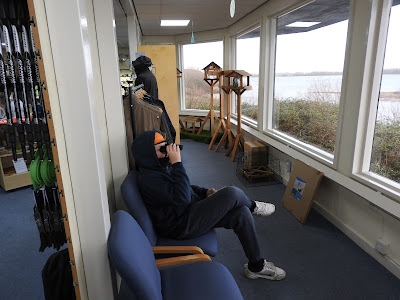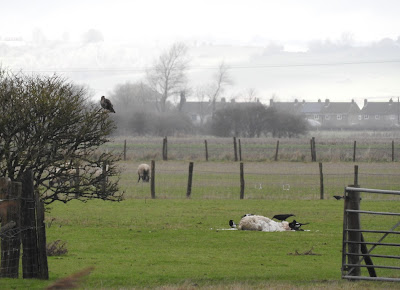Wet and windy, mild - This afternoon I had a run out with my Apprentice Birder, in less than favourable weather conditions. Much of the birding was carried out from the car due to the heavy rain; some of the lanes were flooded and almost impassable, however we still managed to rattle up a respectable 56 species in three hours (he does love a list!). The highlights were: a mixed flock of 47 Bewick`s, two Whoopers and five Mute Swans near Hawthorn Corner, several Cattle Egrets from the Lydd Road, a ringtail Hen Harrier over Burrowes and a cracking view of a Goldcrest by the bird feeders; the sea also delivered Kittiwake, Gannet and Red-throated Diver. The rain did ease off enabling a thorough look through the Teal flock on Burrowes for the Green-winged but without success. So, an excellent afternoon of bonding with the lad then, amid the realisation that my aging eyesight cannot compete with that of a 12 year old!
Birding from the comfort of the VC!Friday 30 December 2022
Reflections on 2022
Wednesday 28 December 2022
Hen Harrier
Mild, wet and windy - This past week (in between all the family stuff) I`ve managed to escape into the surrounding countryside for a wander around the lanes and farmland where standing water is everywhere; sewers and ditches are full to the brim following the recent rainfall with many fields either flooded or super-saturated. Further `tidying up ` of rough field corners and the grubbing out of old willows and hawthorn scrub, so vital for small passerines, continues apace, particularly down Church Lane which was the last place I saw Tree Sparrows locally a year ago. The star bird was yesterday, during a break in the weather, with a ringtail Hen Harrier quartering the arable land across Romney Salts towards the airfield, but otherwise it was a case of Buzzards perched atop lookouts or hovering Kestrels. Small birds were few and far between with the odd Stonechat here and there, several Meadow Pipits, Goldfinches and Pied Wagtails on a dung heap, and stubble fields attracting a few Skylarks, Reed Buntings and Yellowhammers. Sewer margins have lured in a handful of Little Egrets, Grey Herons, Grey Wagtails and flushed Snipes, while a dead sheep along Hope Lane proved attractive to corvids and Magpies after a Buzzard had its fill.
Corvids on sheep, Hope Lane, NRGrubbed up willows and hawthorns, Church Lane, NR
Further afield the wintering Bewick`s Swan flock of up to 50 birds, although mobile, is usually viewable from the back lane crossing Walland Marsh toward Brookland, while the Whooper Swan pair regularly visit the ARC lake. Tuesday evening we checked out Hookers reedbed on the reserve for roosting birds from Dengemarsh Road, where c500 Starlings came to roost along with three Marsh Harriers. Just before Christmas an Iceland and Glaucous Gull were noted along the beach at Dungeness and are hopefully still in the area, awaiting relocation for the New Years Day bird counts...
Wednesday 21 December 2022
Hibernal Solstice
Mild, wet, and windy, SW 3 - With the winter solstice upon us it always seems to me that we`re turning a corner towards steadily longer days with the eventual prospect of spring on the horizon. However, for now the natural world is still firmly in winter mode, and rightly so as the back end of the season often delivers the worst of weather along with food shortages. Out and about across the Marsh this past week has seen us lose the cold polar air for a milder, yet wet and windy, airflow from the Azores. As a result much of the local farmland is super-saturated, attracting thousands of Lapwings and Golden Plovers along with a lesser numbers of Ruff, Snipe and Curlew; particularly at Dengemarsh and the fields beside the airport road where the wintering Dotterel was last reported. Walland Marsh continues to host an increasing herd of 40 odd Bewick`s Swans (including at least 15 juveniles) and up to 20 White-fronted Geese, mainly on arable land to the south of Brookland. Around the bird reserve the two Whooper Swans are regular visitors to the ARC lake, the drake Green-winged Teal is still on Burrowes along with a selection of Caspian Gulls, while Dartford Warblers have been reported from the circular trail. The fields at Boulderwall and along the Lydd Road to Cockles Bridge continue to attract two Glossy Ibises and up to 10 Cattle Egrets.
Sunday 11 December 2022
Dotterel
Cold and wet, SE 3 - A grim day of weather with a heavy overnight frost followed by wintry showers. On the way back from Folkestone this morning I stopped off at Hythe to check out the sea defence blocks for Purple Sandpipers but drew a blank; likewise at St Mary`s Bay along the foreshore checking for Snow Bunting and Lydd Airport fields for Dotterel. Not a great start! However, across the coastal farmland and bird reserve 11 White-fronts were amongst Greylags at Dengemarsh, four Cattle Egrets at Cockles Bridge, two Whooper Swans at ARC, the drake Green-winged Teal showed well enough on a near island at the Makepeace end of Burrowes and a 1st winter Caspian Gull from Dennis`s hide. The weather deteriorated somewhat by late afternoon with heavy sleet and snow showers, just as Martin C had located the Dotterel on fields opposite Cockles Bridge on the airport side, which I managed to see before lights out. Plenty of Golden Plovers, Lapwings, Stock Doves, corvids, Skylarks and several Buzzards were also noted throughout the day.
Egyptian Geese, LyddFriday 9 December 2022
Shorebirds
Cold, dry and misty, N2 - With a nip in the air it was not a morning to be sitting about in a hide, so I opted for a long hike along the foreshore from Littlestone to Greatstone and likewise at Dungeness. There was no sign of any Snow Buntings at places that they`ve been seen before; infact the only passerines noted were a handful of Skylarks, Pied Wagtails, Starlings and Stonechats. As it was high tide there were plenty of waders either roosting on the shingle (Oystercatcher and Grey Plover) or feeding along the tideline (Turnstone, Ringed Plover, Redshank, Dunlin and Sanderling) along with scores of Black-headed and Common Gulls. A diversion to Lade pits turned up very little of note apart from 55 Curlews roosting in a field at the northern end on Romney Salts.
Sanderlings and Dunlins, Littlestone beach
Wednesday 7 December 2022
Red-legs!
Cold, dry and sunny, light airs - At long last some `proper` wintry weather with bright sunshine and the promise of an "Arctic Blast" to come - superb, I love the cold! I started off at Lade pits first thing where wildfowl numbers were particularly low and grebes down to single figures. Raptors were prominent though with a couple of Marsh Harriers, Buzzards and Kestrels present behind the `mirrors`. The Whooper Swan pair were on ARC along with a host of Wigeons, Shovelers, Cormorants, five Pintails, two Marsh Harriers and a Goldeneye, plus five Cattle Egrets and two Glossy Ibis on the paddocks along Lydd Road. Surprise of the day came at Cockles Bridge where a covey of eight Red-legged Partridges were my first of the year; when I first moved down here 17 years ago they were common place, infact we even had them in the garden at Plovers! Local landowners who used to put Red-legs down for shooting now say its not worth their while as predation from, mainly Foxes and Buzzards is unsustainable. Moving onto Dengemarsh where at least eight White-fronts within a large flock of Greylags were viewable form the entrance to Manor Farm. On the airport fields a flock of 280 Curlews was noteworthy, while at least ten each of Bewick`s Swan and Pink-footed Goose showed distantly in fields from Hook`s Wall on Walland Marsh.
Great White Egret, ARCWalk outs around New Romney of late have been noticeable for the paucity of small birds; infact there has been more avian interest in the garden with Goldcrest and Stock Dove the highlights and regular visits from a female Sparrowhawk which took a Collared Dove the other day. In the town park a Mistle Thrush can often be heard in full song, while a couple of football-size, over ripe puffballs were of note in a nearby paddock field.
Friday 2 December 2022
Hen Harrier
Cold, dry and sunny, NE 3 - A check of the front fields at Scotney this morning revealed at least 13 Little Gulls feeding on the far side of the main lake at the Sussex end along with several Black-headed Gulls and hundreds of common dabbling and diving ducks, including 12 Shelducks, with more ducks and geese on the lesser waters. The sward was packed out with feral geese, Wigeons, Golden Plovers, Lapwings and Starlings with thousands more swirling over the farmland towards the wind farm, plus Redshank, Curlew and Green Sandpiper. A scan of the Army ranges delivered a ringtail Hen Harrier, presumably the bird that has been present across the peninsula for a week or more. Around the bird reserve the Green-winged Teal was still on Burrowes, while the usual assortment of egrets and Glossy Ibis could be seen in the paddocks and Boulderwall fields from the Lydd Road. There was a noticeable increase in Lapwing and Golden Plover numbers today, particularly around Dengemarsh and the islands on ARC, having probably moved here from the continent as colder weather is forecast next week. Everywhere I went today birds of prey were present; as a conservative estimate I must`ve seen 15 Buzzards, 10 Marsh Harriers, eight Kestrels, a Hen Harrier and a Peregrine. Buzzard numbers are now so high that they`ve moved onto the coastal wetlands where they compete with the harriers for food. It will be interesting to see how these two apex predators realign as I`ve seen many encounters between the two raptors recently, mostly with the stronger Buzzard coming out on top.
Thursday 1 December 2022
Green-winged Teal
Cold, overcast, N 1 - A miserable sort of morning with a fine mizzle throughout. Having been away for a few days I started on the local patch at Lade where the usual range of ducks included 240 Pochards. Around the willow swamp and reedbeds a few Cetti`s Warblers, Chiffchaffs, Goldcrests and Long-tailed Tits vocalised, plus two Marsh Harriers quartering the airport fields. At Dungeness the sea was quiet, but the Patch delivered three Little Gulls over the boil amongst a dozen Black-headed and Common Gulls. Next stop the bird reserve and a scan for last weekends drake Green-winged Teal, which was eventually located lurking amongst some 200 Teal at the southern end of Burrowes, from where more Chiffchaffs and Cetti`s Warblers called in front of Makepeace lookout; two Goldeneyes were also noted from Dennis`s hide. On the Boulderwall fields and along the Lydd Road the now expected heron fest comprised four Cattle, two Great White and a Little Egret, two Grey Herons and a pair of Glossy Ibis. Over the road on ARC it was a case of `as you were` with the usual wildfowl, plus a Kingfisher from the Axle Lookout.
Kingfisher, ARCLast weekend whilst in West Sussex visiting family I sloped off for a day to explore the Arun Valley, mostly at Amberly Wild Brooks and also from the nearby Rackham viewpoint. Needless to say following the heavy rain throughout November the valley flood-plain was well and truly swollen with large parts completely flooded. Consequently, Wigeon, Gadwall, Shoveler, Teal and feral geese were numerous, along with hundreds of Lapwings and Black-tailed Godwits plus a few Redshank, Snipe and Dunlin. From Rackham I had distant views of a White-tailed Eagle harrying a Greylag; apparently there have been two birds present of late in the valley, mostly seen from Pulborough Brooks. Also noted plenty of Fieldfares and Redwings, Kestrel, Sparrowhawk and a Sika Deer.





.JPG)

.JPG)
.JPG)
.JPG)

.JPG)
.JPG)
.JPG)



